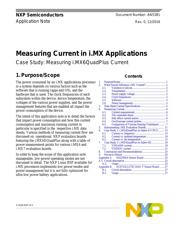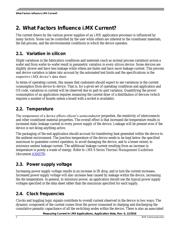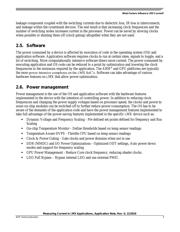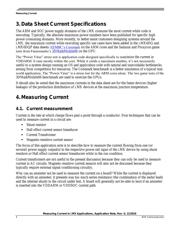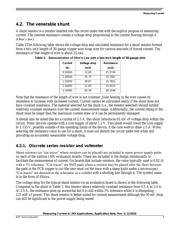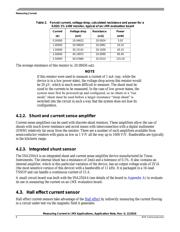herunterladen

© 2016 NXP B.V.
Measuring Current in i.MX Applications
Case Study: Measuring i.MX6QuadPlus Current
1. Purpose/Scope
The power consumed by an i.MX applications processor
in a system depends on various factors such as the
software that is running (apps and OS), and the
hardware that is used. The clock frequencies of each
subsystem within the device, device temperature, the
voltages of the various power supplies, and the power
management features that are enabled all impact the
power consumption of the device.
The intent of this application note is to detail the factors
that impact power consumption and how this current
consumption and maximum running current in
particular is specified in the respective i.MX data
sheets. Various methods of measuring current flow are
discussed on operational NXP evaluation boards
featuring the i.MX6DQuadPlus along with a table of
power measurement points for various i.MX6 and
i.MX7 evaluation boards.
In order to keep the scope of this application note
manageable, low-power operating modes are not
discussed in detail. The NXP Linux BSP available for
i.MX processors implements low power modes and
power management but it is not fully optimized for
ultra-low power battery applications.
NXP Semiconductors
Document Number: AN5381
Application Note
Rev. 0
,
12/2016
Contents
1. Purpose/Scope ................................................................. 1
2. What Factors Influence i.MX Current? ............................. 2
2.1. Variation in silicon................................................ 2
2.2. Temperature ......................................................... 2
2.3. Power supply voltage ............................................ 2
2.4. Clock frequencies ................................................. 2
2.5. Software ............................................................... 3
2.6. Power management ............................................... 3
3. Data Sheet Current Specifications .................................... 4
4. Measuring Current........................................................... 4
4.1. Current measurement ............................................ 4
4.2. The venerable shunt .............................................. 5
4.3. Hall effect current sensor ...................................... 6
4.4. Oscilloscope current probes................................... 7
4.5. Comparison of Various Sensing Techniques .......... 7
5. Instrumenting i.MX Evaluation Boards .......................... 11
6. Case Study 1: i.MX6QuadPlus on Sabre-AI CPU3 ......... 13
6.1. Current vs. frequency .......................................... 13
6.2. Current vs. ambient temperature .......................... 14
6.3. Current vs. die temperature ................................. 15
7. Case Study 2: i.MX6QuadPlus on Sabre-SD................... 18
7.1. VDDARM current .............................................. 18
7.2. VDDSOC current ............................................... 21
8. Conclusions and Recommendations ............................... 23
9. Revision History ........................................................... 24
Appendix A. INA250A4 Sensor Board .............................. 25
A.1. Circuit description ......................................................... 25
A.2. Usage ................................................................. 25
Appendix B. ACS723LLCTR-10AU-T Sensor Board ........ 27
B.1. Circuit description .............................................. 27
B.2. Usage ................................................................. 27
Verzeichnis


